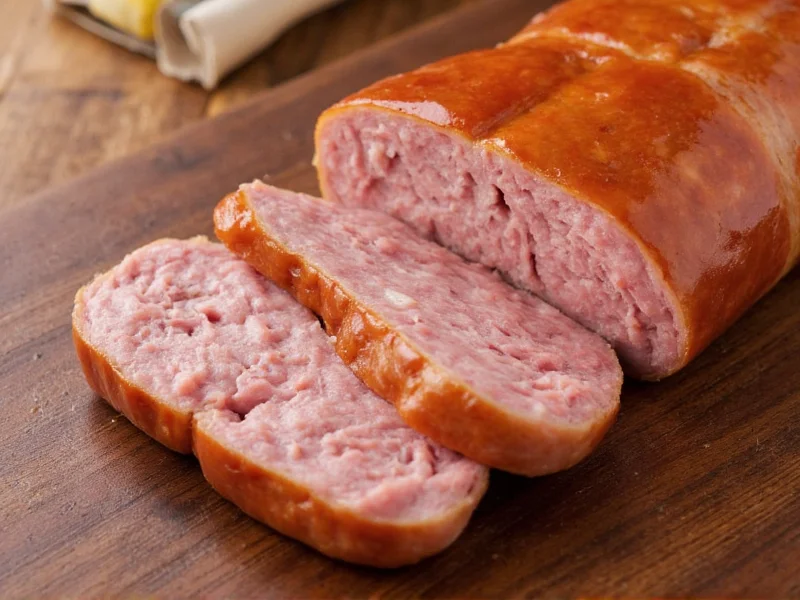Properly cooked sausage delivers both safety and optimal flavor. Undercooked sausage poses serious health risks from pathogens like Salmonella and E. coli, while overcooked sausage becomes dry and tough. This guide provides science-based methods to determine sausage doneness with precision, ensuring you achieve perfectly cooked results every time.
The Science Behind Sausage Cooking
Sausage doneness isn't just about eliminating pathogens—it's a precise chemical process. When meat reaches specific temperatures, proteins denature and coagulate, forcing out moisture while creating that desirable firm-yet-juicy texture. The critical temperature threshold destroys harmful bacteria without compromising texture. Understanding this process helps you move beyond guesswork to reliable cooking results.
Using a Meat Thermometer: The Gold Standard
No method beats a digital instant-read thermometer for accuracy. Here's how to use it properly:
- Choose the right thermometer - Digital instant-read models provide the fastest, most accurate readings
- Insert correctly - Place the probe into the thickest part of the sausage, avoiding casings or bones
- Check multiple spots - Especially with larger sausages or when cooking in batches
- Verify calibration - Test in ice water (32°F/0°C) or boiling water (212°F/100°C) periodically
| Sausage Type | Safe Internal Temperature | Visual Indicators |
|---|---|---|
| Pork, Beef, Lamb, Veal | 160°F (71°C) | Light brown, firm but springy |
| Poultry (Chicken, Turkey) | 165°F (74°C) | White or light tan, no pink |
| Pre-cooked Smoked Sausage | 140°F (60°C) | Heated through, steaming |
Visual Indicators: Secondary Verification Methods
While never a substitute for temperature verification, these visual cues can provide additional confirmation:
Color Changes
Fresh pork and beef sausages transition from pink to taupe or light brown. Poultry sausages change from pinkish to white or light tan. Important: Some sausages contain curing agents that maintain pink color even when fully cooked, so color alone is unreliable.
Juice Appearance
When properly cooked, sausage juices run clear rather than pink or red. However, piercing sausage to check juices causes moisture loss, so this method should be used sparingly.
Texture and Touch Tests
Experienced cooks develop a sense for sausage doneness through texture:
- Firmness test - Properly cooked sausage feels firm but not hard. Gently press with tongs; it should spring back slightly
- Bounce test - When lifted with tongs, sausage should have some bounce rather than feeling limp
- Weight comparison - Cooked sausage feels noticeably heavier than raw due to rendered fat absorption
For reference, properly cooked sausage should feel similar to the fleshy part of your palm below the thumb when your hand is relaxed.
Cooking Time Guidelines (With Important Caveats)
While cooking times provide rough estimates, numerous variables affect actual doneness:
- Stovetop - 15-20 minutes for 1-inch diameter sausages, turning frequently
- Grill - 12-18 minutes over medium heat, turning every 3-4 minutes
- Oven - 20-25 minutes at 375°F (190°C)
- Air fryer - 10-15 minutes at 375°F (190°C), shaking basket halfway
These times vary significantly based on sausage thickness, starting temperature, cooking equipment, and ambient conditions. Always verify with a thermometer regardless of elapsed time.
Common Mistakes to Avoid
Even experienced cooks make these critical errors when determining sausage doneness:
- Relying solely on color - Cured sausages remain pink when safe to eat
- Cutting sausages to check - Causes precious juices to escape, drying out the meat
- Ignoring carryover cooking - Sausage continues cooking 5-10°F after removal from heat
- Not resting before serving - Rest 3-5 minutes to allow juices to redistribute
- Using inaccurate thermometers - Test calibration regularly for food safety
Special Considerations for Different Sausage Types
Not all sausages follow the same doneness rules:
- Pre-cooked smoked sausages - Only need heating to 140°F (60°C) as they're already cooked
- Fresh bratwurst - Can be slightly pink at 160°F due to curing ingredients
- Italian sausage - Often contains breadcrumbs that affect texture perception
- Breakfast sausages - Smaller size requires shorter cooking time but same temperature
Food Safety Essentials
Proper sausage cooking is a critical food safety practice:
- Always wash hands and surfaces after handling raw sausage
- Never place cooked sausage back on plates that held raw meat
- Refrigerate leftovers within 2 hours (1 hour if above 90°F/32°C)
- Consume leftovers within 3-4 days or freeze for longer storage
- Thaw frozen sausage in the refrigerator, not at room temperature
Remember that visual doneness indicators alone cannot guarantee pathogen elimination. The USDA consistently recommends thermometer use for meat products to prevent foodborne illness.
Practical Tips for Perfect Sausage Every Time
Implement these professional techniques for consistently excellent results:
- Bring sausage to room temperature for 20-30 minutes before cooking for even heating
- Use medium heat rather than high to prevent casing rupture while ensuring thorough cooking
- For grilled sausage, create a two-zone fire to move sausages away from flare-ups
- When pan-frying, add a small amount of water and cover for the first 5 minutes to ensure thorough cooking without burning
- Always rest sausage for 3-5 minutes after cooking to allow juices to redistribute











 浙公网安备
33010002000092号
浙公网安备
33010002000092号 浙B2-20120091-4
浙B2-20120091-4